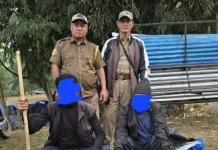[ Obang Tayeng ]
Spread over an area of 217 sq km, with altitudinal range of 500 meters to 3500 meters from sea level under Shergaon Forest Division in West Kameng district of Arunachal Pradesh, the Eaglenest Wildlife Sanctuary is a major centrepiece of nature lovers all over the world.
This unique sanctuary in the Himalayan region is also a successful model of joint government and community conservation endeavour. Bifurcated from Pakke Wildlife Sanctuary in 2011, this sanctuary is the richest biodiversity hotspot in the world after the Andes in South America.
A birder’s paradise, the Eaglenest Wildlife Sanctuary is a popular destination for all kinds of nature lovers and tourists who visit the place from October to March every year for study of its rich flora and fauna, especially study of birds.
Over 700 species of birds are found here. The bird species of Bugun Liochigla is also only found here in the sanctuary. Besides these, various species of mammals, amphibians and lizards, moths and butterflies and vegetation, including many varieties of rhododendrons are found in the region. This is the centrepiece of the Kameng Protected Area Complex, covering an area of 3,500 sq km of mostly contiguous forests spread across the two states of Assam and Arunachal Pradesh in five protected areas.
Genesis: Eaglenest has derived its name from Red Eagle Division, a regiment of the Indian Army, which used to operate in the region in the 1950s. A road known as Chacku Foothill Tenga (CFT Road) runs through the sanctuary from Ramalingam, at a distance of 8km from Tenga to kamengbari in the Assam-Arunachal boundary. The 14th Dalai Lama also used this tract to travel from Tibet to the plains of Assam in 1959 and stayed at a site called Sharua, at an elevation of 2500 mts ASL, inside the Bugun community forest land. To commemorate his legacy, a site known as ‘Lama Camp’ is set up at the site where tented accommodation facilities are offered to tourists by local tour operators.
Discovery of Bugun Liochichla: This unique sanctuary gained more prominence in 2006 with the rare discovery of the Bugun Liochichla, a rare bird spotted by Dr Ramana Athreya, an ornithologist and head and co-ordinator of the Biodiversity Research and Conservation. Dr Athreya started working here since 2003 by involving the local community members. This species of bird is found only here in the entire world. The locals don’t have a name for it as they have not seen this bird in the past, informed Indi Glow, the head of Singchung Community Reserve Forest.
Dr Ramana began to involve the local Bugun community in his study of the bird and has motivated them to conserve the wildlife in the area since 2003. This discovery of the Bugun Liochichla was described as the most sensational ornithological discovery in India in the last 50 years, for which he was awarded several prizes, including the Pakhishree Award and Whitley Award for his endeavour in conservation and motivation of local communities. He inspired local youths, including Indi Glow, presently a leader of an NGO called Singchung Bugun Community Reserve Forest, on the importance of conservation.
Turning Point: With the involvement of the locals by Dr Ramana Athreya in study of birds and subsequent discovery of Bugun Liochichla, some local Bugun members began to realize the importance of conservation of nature.
Athreya maintains that communities need to be made an integral part of conservation efforts. According to him, in Arunachal Pradesh, “Conservation largely operates in a knowledge vacuum. The management of wildlife sanctuaries is based on few data and with virtually no inputs from the communities who impact them most.”
He believes that along with conservation, economic benefits should also be given to the communities.
At this point, Divisional Forest Officer of Rupa Forest Division, Millo Tassar began to motivate them further. After a series of discussions and meetings with the locals, he finally convinced them to get involved actively in the conservation process in a tract of community forest measuring about 17 sq km, which is contiguous to the Eaglenest Wildlife sanctuary.
Presently, this forest area is effectively managed by their NGO, the Singchung Community Reserve Forest. This NGO organizes awareness camps on conservation, which includes training on bird watching, snake handling and cleaning plastics and other environmentally harmful objects used by visitors in the area.
When quizzed about the new development, Glow said, “It was Dr Athreya who first inspired us and involved some of us in his study of birds. Then DFO Tassar came and advised us to participate in the conservation process. With his support and initiative, this Bugun Community Reserve Forest came up.”
The Buguns, who were till recently hunters like many co-tribes of the state, have now completely given up hunting and turned preservers of wildlife.
According to Glow, the transformation is in the interest of the locals as many of them have been absorbed in patrolling jobs, as tour guides and tour operators. Also, their NGO receives monetary grants from both national and international environmental agencies.
Glow, a sincere and dedicated youth in his 30s has further plans to upgrade the present infrastructure for tourists at the Lama Camp where they have set up an office.
“Since the site is devoid of electricity and proper lodging facilities, installation of solar lighting system and better lodging infrastructure is of utmost importance”, he says, adding that “food is a problem here because we can’t install refrigerators because of lack of electricity. Otherwise, visitors love this place immensely”.
Furthering the concept: In Arunachal Pradesh, there are a few wildlife sanctuaries of equal importance from the conservation point of view. Prominent among them are the Pakke Tiger Project, Daying Ering Wildlife Sanctuary and Miao National Park -all of which are immensely rich in wildlife resources.
If a cue can be taken from the Eaglenest story by making the concerned community members active partners in the entire conservation process, the results can be amazing. A sense of responsibility and integration of the communities with the entire system of eco-management can bring about a positive change in the way conservation projects are usually managed. (The contributor is Director, IPR, Govt of Arunachal Pradesh).




